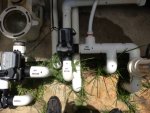Yes, I have a suggestion. I have had to use this when a former boss screwed up a plumbing install, 50 miles from the nearest plumbing supply store.

You will need to cut the fittings at the red lines. When that is done, you will need to cut through the fitting sleeve that is left on the pipe, being careful no avoid cutting into the pipe itself. Do this in several places around the pipe, and with a sharp chisel carefully peal each section off of the pipe. This will leave a rough surface that will need to be carefully sanded somewhat smooth, doesn't have to be perfect. Just enough so you can slip a coupler or other fitting onto the end of the pipe. The cleaner/primer will finish smoothing the surface enough for the glue to "bite" into the pipe.
When you get both 90's off in this manner, you can extend your plumbing in whatever manner appropriate for your new SWG.
If you happen to chip a bit of the pipe off, as long as the chipped section will still be covered by at least half of the depth of the new fitting you should be good.
This method has worked for me on pipes with 40 - 80 psi pressure (normal city water) without failure, so I think that the 10 - 40 psi from your pool pump won't bother it.
If you accidentally crack the pipe outside where the new fitting will cover, you can adapt this method for removing the stub from the next fitting and then smooth the inside of it. A little harder to do, but can be done.


 Welcome to TFP!!!
Welcome to TFP!!!



